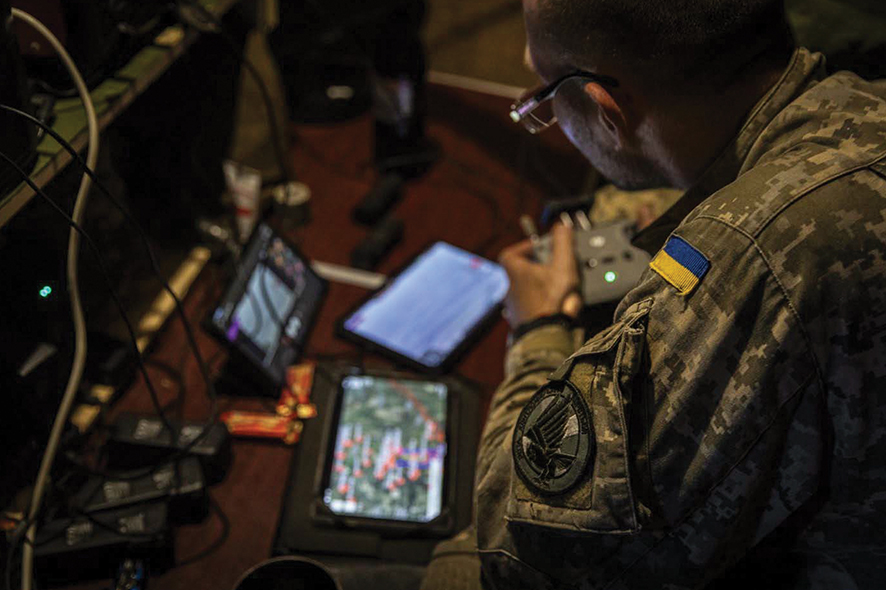In the rapidly evolving landscape of modern military operations, the integration of Artificial Intelligence (AI) into command, control, and communications (C3) systems is poised to redefine how military leadership operates at both tactical and operational levels. Anyone on social media has likely noticed the uptick in AI-related posts, leading to claims it will overturn all modern aspects of life. More broadly, as global powers continue to funnel investments into AI technologies, the implications for defense strategies and decision-making processes are becoming increasingly evident. AI in C3 is no longer just an innovative tool, but is fast becoming an indispensable element for military leadership, given its potential applications and recent advancements.
The integration of AI in military operations is not a novel concept. The roots of AI in defense can be traced back to the Cold War era, when rudimentary AI systems were developed to enhance strategic decision-making and improve weapons systems. In more recent conflicts, such as the wars in Iraq and Afghanistan, AI technologies were employed for surveillance, target acquisition, and predictive analysis. These early implementations laid the groundwork for the sophisticated AI systems seen today in the Ukrainian conflict, where advanced algorithms and machine learning models are being utilized to gain a strategic edge.
AI possesses the extraordinary capability to process vast amounts of data in real-time, granting military commanders an unprecedented level of situational awareness on the battlefield. This is especially crucial at both tactical and operational levels, where split-second decisions can alter the course of engagements. During the conflict in Ukraine, commanders have harnessed AI-driven real-time information systems to monitor enemy movements, anticipate threats, and deploy resources with remarkable precision.
AI algorithms can analyze satellite imagery, drone feeds, and ground sensor data to detect patterns and anomalies, providing commanders with actionable intelligence. More recently, AI has been employed to enhance target acquisition, including the use of first-person-view (FPV) drones, which have become ubiquitous as both offensive and defensive weapons. These drones, as well as others, have become essential to any commander’s intelligence, surveillance, and reconnaissance (ISR) toolkit.
The ability of AI to sift through complex data streams allows commanders to rapidly identify critical information, such as enemy positions, troop movements, and logistical vulnerabilities. This capability not only bolsters the safety and effectiveness of military operations but also facilitates proactive decision-making that can preempt enemy actions. Additionally, the data pool can incorporate lessons learned from friendly and allied forces, thereby reducing the likelihood of repeat errors.

AI-powered decision support systems (DSS) are increasingly becoming integral to military command structures. These systems can analyze historical data, simulate scenarios, and recommend optimal courses of action based on predefined parameters and real-time inputs.
In the Ukrainian conflict, AI-driven DSS have been tested and used to predict potential avenues of attack and suggest countermeasures. By integrating AI with command centers at the brigade and below levels, military leaders can receive automated recommendations that consider multiple variables, including terrain conditions, weather patterns, and enemy capabilities, both past and present.
Such systems not only streamline decision-making processes, but also reduce the cognitive load on commanders, allowing them to focus on strategic planning and mission execution. By leveraging AI, military organizations can achieve greater agility and responsiveness in highly dynamic operational environments.
AI facilitates network-centric warfare by connecting disparate systems and enabling seamless communication between units and command centers. This new interconnectedness enhances command agility by ensuring that decision-makers have access to real-time data and intelligence from across the battlefield.
In Ukraine, commanders have employed AI-driven C3 systems to coordinate multi-domain operations, such as combined arms maneuvers and joint airstrikes. AI facilitates communication interoperability between air, land, and sea forces, enabling synchronized actions that exploit enemy vulnerabilities.
By integrating AI into C3 frameworks, military leaders can orchestrate complex operations with vastly enhanced precision and effectiveness. This interconnectedness fosters a cohesive operational environment where information flows freely, enabling rapid adaptation to changing circumstances and mission requirements.
However, the advantages of AI-integrated battlefield management and C3 do not come without obstacles. The deployment of AI in military operations is fraught with ethical and practical challenges. Increased network signatures on the battlefield, cybersecurity concerns, and physical equipment requirements must all be considered. These vulnerabilities must be weighed against the benefits, particularly in command, control, and communications.
While AI promises to revolutionize military operations by enhancing situational awareness and automating decision-making processes, there are significant concerns. One major issue critics highlight is the potential for AI systems to make autonomous decisions without human oversight, raising questions about accountability and the risk of unintended consequences. Additionally, algorithmic biases in AI systems can lead to flawed decision-making, potentially causing harm to civilians and friendly forces.
These concerns have incentivized international collaboration. The global community has closely observed Ukraine’s use of AI in its military strategy, with many allied nations providing support and collaboration. NATO, for instance, has shared AI research and resources to bolster Ukraine’s defense capabilities. Conversely, Russia, with its resources limited by sanctions and embargoes, has sought assistance from countries like China and Iran to develop similar systems.
As evidenced by the conflict in Ukraine, AI-powered C3 systems are already shaping how commanders gather intelligence, plan operations, and execute missions in real-time. The ability to process and analyze vast amounts of data quickly gives military leaders a decisive advantage on the battlefield, enabling them to anticipate threats, exploit opportunities, and achieve mission objectives with greater efficiency and precision, while reducing the threat to civilians and non-military infrastructure.
Looking ahead, continued advancements in AI technology will likely see further integration into defense systems, including the development of autonomous systems capable of independent decision-making. However, the ethical and strategic implications of AI in warfare remain subjects of ongoing debate, necessitating careful consideration of its impact on international security and military ethics.
AI in C3 represents not just a technological advancement, but a paradigm shift in military strategy and operations. By harnessing the power of AI, military forces can enhance their capabilities, mitigate risks, and maintain strategic superiority in an increasingly complex and contested global environment.
Defense Sector Review is an analysis of the regional and relevant security and defense issues by the team at Mercury Strategic Services, a defense consulting, training, and advisory company based in Tbilisi, Georgia and at www.mercstrat.com.














